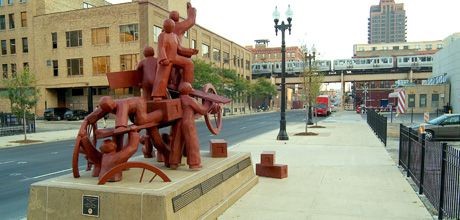Haymarket Memorial - Haymarket Massacre Monument
Introduction
Text-to-speech Audio
Images
"Haymarket Memorial" statue: 2004 by Mary Brogger. Bronze monument commemorating the 1886 Chicago Haymarket riot, an internationally significant and volatile event in the struggle between business, labor, and law enforcement.

Backstory and Context
Text-to-speech Audio
The Haymarket Affair is considered a watershed moment for American labor history, at a time when fears about the loyalties and activities of immigrants, anarchists, and laborers became linked in the minds of many Americans.
On May 3, 1886, unarmed strikers clashed with police at Chicago’s McCormick Reaper Works factory. The deaths of six workers became a call for direct action, and a public rally was called for the following day to be held in Haymarket Square. Again, the police and the strikers clashed, but this time a bomb was thrown, resulting in the death of seven policemen and many in the crowd were injured. The police, uncertain about the source of the bomb, fired into the crowd, killing four of the demonstrators.
The identity of the bomb thrower is still a mystery, but eight men were indicted on charges of conspiracy to commit the act. All eight were convicted of the conspiracy charge even though it was understood none had made or thrown the bomb. August Spies, a German anarchist, laborer, and activist, and Albert Parsons, a socialist laborer, activist, and former Confederate soldier from Texas, had been among the fiery and well-known speakers at the rally. Spies and Parsons, along with Adolph Fischer and George Engel, were executed by hanging. Louis Lingg, the fifth condemned to die, managed to commit suicide while awaiting his sentence by biting down on a blasting cap in his cell. Three other defendants, Samuel Fielden, Oscar Neebe, and Michael Schwab, were sentenced to prison terms, but were pardoned in 1893.
Cite This Entry
Cuskarovska, Bojana, Kalen Martin-Gross, and Clio Admin. "Haymarket Memorial - Haymarket Massacre Monument." Clio: Your Guide to History. January 16, 2019. Accessed March 6, 2025. https://theclio.com/entry/11509

